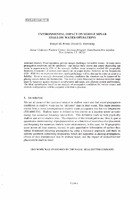| dc.contributor.author | Monti, Joseph M. | |
| dc.contributor.author | Browning, David G. | |
| dc.date.accessioned | 2018-10-11T14:05:45Z | |
| dc.date.available | 2018-10-11T14:05:45Z | |
| dc.date.issued | 1993/08 | |
| dc.identifier | 806 | |
| dc.identifier.govdoc | CP-42/2 | |
| dc.identifier.uri | http://hdl.handle.net/20.500.12489/140 | |
| dc.description.abstract | Shallow Water operations provide unique challenges for mobile sonars. In many cases propagation conditions can be optimized - our studies have shown that sound channeling can occur in approximately 75% of the strategic shallow water scenarios studied (10 geographic locations, 4 seasons) - if sensors (and targets) are at proper depths. However, at low frequencies (500 - 4000 Hz) we must consider how significant leakage will be; this can be either an asset or a liability. Even in strongly downward refracting conditions the situation can be improved by placing sensors below the thermocline. The need to lower frequency to increase detection range must be balanced against increased reverberation and noise, and ultimate system performance. The ideal optimization based on our analysis of propagation conditions for various source and receiver configurations will be compared with what is practical. | |
| dc.format | 17 p. : ill., 21 fig. ; digital, PDF file | |
| dc.language | English | |
| dc.publisher | NATO. SACLANTCEN | |
| dc.source | In: Low frequency active sonar (SACLANTCEN Conference Proceedings CP-42), vol. 2, 1993, pp. F/18-1 - F/18-17. | |
| dc.subject | Sonar | |
| dc.subject | Low Frequency Active Sonar (LFAS) | |
| dc.subject | Shallow water | |
| dc.subject | Naval warfare and operations | |
| dc.subject | Acoustic propagation | |
| dc.subject | Transmission loss | |
| dc.subject | Modelling and environmental measurements | |
| dc.title | Environmental impact on mobile sonar shallow water operations | |
| dc.type | Papers and Articles | |
| dc.type | Conference Proceedings (CP) | |
